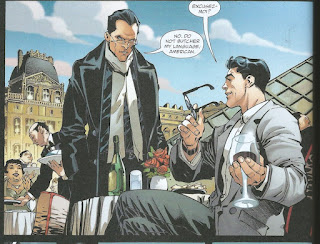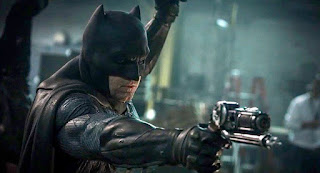Pick of the Brown Bag
March 15, 2022
by
Ray Tate
Welcome to a new Pick of the Brown Bag. I'm Ray Tate, the creator, writer and all around Grand Pooh-Bah of the POBB. This week I look at the hardback collection Batman The Detective written by Tom Taylor, illustrated by Andy Kubert, Sandra Hope and Brad Anderson. Need the main gist rather than the in-depth look? Check me out on Twitter: #PickoftheBrownBag.
First, let me just say I love a nicely priced hardback such as this. Collecting all six issues of Batman The Detective it goes for $24.99, which is a fair price.
Those cash strapped may be able to purchase it cheaper through Amazon or Barnes and Noble. Better yet, check it out at your local library. Batman The Detective is listed in The Library of Congress: ISBN 978-1-77951-418-9.
The paper bears a newsprint texture and presentation. Though, don't worry; a single sheet is much thicker than a newspaper. Think thicker than an average comic book page but thinner than sketchpad paper. Made from "sustainable forests" according to the imprint. So good on DC.
The overall quality is excellent for picking up the detail of Kubert's and Hope's illustration as well as Brad Anderson's colors. Plus, the nature of the paper makes the collection lightweight. The story anything but.
Taylor sets Batman The Detective some time after Alfred's death. I don't actually know if this tale evolves in continuity proper. Points of interest suggest yes and otherwise.
I tend toward the later. If anything, Taylor seems to be exploring the legend of Batman and a glimpse of the man behind the legend. Unlike, the actual person, who visits in a Superman Son of Kal-El Annual.
Embarrassment, self-deprecating wit. All elements of a person. Anyway, it's a nuance of flavor rather than a drastic schism.
Taylor presents Bruce Wayne as much older in Batman The Detective. Kubert, Hope and Anderson bestow a very unusual and off-putting look to Bruce. They drastically contrast his typical appearance in comics. They furthermore reintroduce him with scars and all.
Taylor and company give no specifics, and that benefits the theme of the story. This Batman mystery however could not have happened at any time or any place in Batman's history and it's far too grounded to be an elseworld. The Detective takes place in a seasoned Batman's world. Batman though suffers no physical indignities like his alter-ego. He's iconic even if older.
You really cannot mistake Batman for anybody else, despite the lack of a cape. He still cuts an impressive imposing figure. This Batman may be anywhere from fifty to seventy, but hell no, you do not want to mess with him.
No matter the tale's placement in time and space. It's Batman's present. We see flashbacks to when Batman looked more like the Batman from the comics.
The literal signature left after a downed plane in Lancashire draws Batman to England. The woman who first combats the terrorists while still on the plane is Beryl Hutchinson. That name may sound familiar. Beryl holds a particular history with the Dark Knight.
Beryl Hutchinson is the Knight. She used to be Squire to Cyril Sheldrake. The second Knight. Grant Morrison introduced the duo in his run of JLA. Cyril was the original Squire to the original Knight Percy Sheldrake, the Earl of Wordenshire.
These heroes premiered historically in a 1950s issue of Batman and joined the Batman of All Nations a year or so later in Detective Comics.
The creative team of Batman The Detective debuts a new squire for Beryl who teams up first with Batman, then Beryl who recovers from her ordeal.
Don't be surprised that she's recovering from the landing. She's been touched by the Bat. People touched by the Bat tend to be tough customers. More of that legend I spoke of.
Now if you think I'm uncharacteristically spoiling a lot of Batman The Detective, think again. Batman The Detective is just that. Throughout the story, Batman must deduce why these murders occur. Who isn't important. In fact, I will state right here. You don't know who that person is.
She hasn't previously been seen in a Batman book, regardless of era. So, this isn't a fair play mystery where you deduce the killer of a body in the library. It's instead a cutting edge detective story.
The costume of course should look familiar to you, but it goes much deeper than Batman mockery. Writer Leo Dorfman and artist Neal Adams created the Batman Revenge Squad in an issue of World's Finest.
Sounds impressive, doesn't it? The Batman Revenge Squad. Oooooo. Ahhhhh. These guys have never been seen in World's Finest, Batman, Detective Comics before that story.
Taylor and company updates the idea with an abnormal psychological twist that makes the crime worthy of Batman's involvement. Even the choice of colors pertains to the rationale. Neal Adams probably chose the colors for the BRS for aesthetic reasons. I doubt anything deeper.
In Chapter one, before Batman embroils himself in the heart of the mystery, he matches wits and fists against an old enemy.
One of several parallels Taylor makes between Batman and Holmes. Indeed, the creative team take Holmes' tacit historical acceptance of Batman being his successor in an anniversary issue of Detective Comics as now explicit.
If Taylor had started the second act of chapter one with Batman redirected to the hospital where Beryl recuperates, he would have too easily created a generic feeling, despite the presence of Tower Bridge in the background. This prologue just speaks of Batman in England.
The new Batman Revenge Squad, who have a more meaningful name, seek to eliminate Beryl from the equation, and that's one of many mistakes they make.
Reading the narrative that goes along with this giddy moment of relishing the Batman. Taylor lets in a little depth to the legend. Something very fitting to the character of Batman yet original.
A duality exists within these pages, a purposeful conflict between the artwork and the writing. Batman feels the weight of reality. His appearance does not. He looks like he could fight the good fight forever. His mind knows better. Again, this is the glimpse of the man behind the legend, yet not as personal a look as in the Superman Annual.
Chapter two begins at Big Ben, where Batman relies on a classic method of Batman interrogation. This is the legend. This is Batman as a figure of terror to criminals. Batman does not kill. Part of the legend, yet from the criminal's point of view, he's mean enough to renege on that vow at any point in time. Do you want to be the first?
In this chapter Batman gets to know the Knight's Squire Amina. It's a delightful subplot that you should pay attention to as you read.
It does not connect in any way to the main mystery. Just put that out of your mind. As you can see by the graphic, even though Taylor is doing more exploration than usual, he nevertheless infuses The Detective with a lot of Batman related comedy. Amina thinks living with the new Knight is pretty cool, but she becomes awestruck just like her mentor over Batman.
Chapter two and three centers on the first mystery guest that becomes inveigled in the Batman Revenge Squad. I can't really say much about the guest, other than he anachronistically looks in better shape than Bruce. That appears to be artistic license dedicated in part to Batman's high moral standard. This character doesn't possess Batman's conscience. He therefore had an easier time of it. Here we also see images of a younger, classic Bruce Wayne.
Chapter four brings a Bondish flair to Bruce Wayne as he hits direr straits with law enforcement. By this time, Batman's quest for answers takes him to Paris, and it's in the custody of the Surete, that Batman unravels the mystery for readers.
Batman throughout each era of his published history protected his secret identity in unique ways. In Batman The Detective, these clever ruses get reversed on him.
The reversal produces a moment of genuine tension that demonstrates how you can coax suspense out of a situation from a character who simply refuses to die.
Chapter five brings on the cool and the legend. These scenes I won't spoil because they're simply breathtaking. The design, the meaning behind the plot device, the sight gags or Easter Eggs if you prefer, all congeal into what Batman is. Taylor also includes an instant that reflects another scene in the Superman Annual. Batman is beginning to see how Alfred took care of him all these years, not just in the grand scheme but these tiny slivers that kept him human and addressed human needs that he wouldn't admit.
Chapter five furthermore introduces a superb updating of a Sherlock Holmes method Batman adopts. Using the connectivity of the world, Batman creates his own network of Irregulars.
In this and the final chapter, Batman proves his myth. This is what writers like Taylor, like King, like Snyder, like Morrison, like O'Neil, like myself have been saying all along. Batman is so much more than just a crimefighter. He's so much more than just a guy in costume. He's so much more than a martial artist. He's so much more than a sleuth. He is as Morrison termed him "The most dangerous man on the planet." He is the acknowledged successor to both Sherlock Holmes and the Shadow. He is Batman. Batman is really as Geoff Johns implied about hope. That's what Batman The Detective is really about. Batman making a mark like no other mortal man. One man changing the outcome of so many lives. One man changing the tide of history because he's just that good.






























